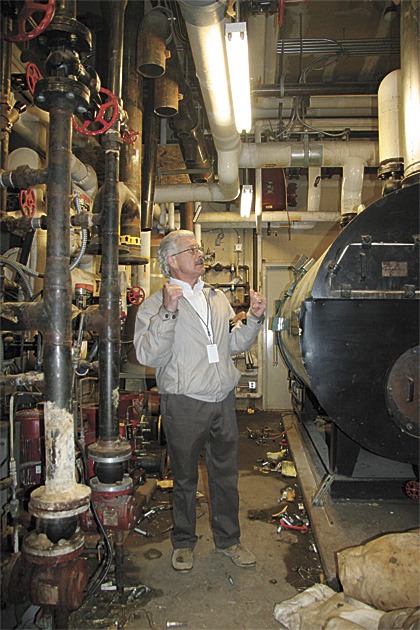When students came back from spring break this week, the hallways and classrooms of Mount Si High School seemed a little colder.
The chilled school was due to a dismantled heating system, removed by construction workers to make way for a new hydrovac geothermal heating and cooling system. The new technology is more environmentally friendly and is projected to save nearly half the school’s current heating costs.
Installation began on spring break and will continue to September. The Snoqualmie Valley School District has been planning the new system, paid for through a 2009 bond, since July.
“We’re rebuilding the entire heating, ventilation and air conditioning (HVAC) system,” said Clint Marsh, construction program manager for Snoqualmie Valley School District.
Body heat
Mount Si’s air conditioners were pulled in December. Now, only the school’s ventilation system is keeping teens cool.
“When it is 60 degrees outside, this building has the tendency to get hot because there’s 1,500 students in it,” Marsh said. “Each person puts off about 500 BTU’s — that’s about 750,000 BTU’s of heat once the kids show up.”
A BTU, or British thermal unit, is the amount of energy needed to heat one pound of water one degree Fahrenheit.
As heat and cooling has been shut down, the plan is to use student body heat to keep the school comfortably warm and cooler into the spring season.
Cold temperatures at school aren’t going to be the norm.
“We had that anamoly of a storm come through when the school was shut down for a whole week. Crews were working with all the doors open,” Marsh said. “People may think it’s crazy that we heat the building with body heat from students, but keep in mind that’s a design factor.”
Water from the earth
The new HVAC system, also called a hydronic system, uses piped water to heat, cool and ventilate the building. Before, fans pulled air from outside to moderate temperatures.
Workers are gutting the Mount Si boiler room , converting it to an electrical and storage room. A new boiler room will reside in a building on the back side of the school.
“The old stuff we’re taking out has run its useful life,” Marsh said.
Two wells are being dug behind the school, connecting to Snoqualmie aquifer, one of the largest in the state. The shafts are 610 and 540 feet deep.
Water from one wells will run through a heat exchanger in the new boiler room and circulate back out to the second well.
In the heat exchanger there are two plates. As the 55 degree water from the aquifer enters the heat exchanger, it heats an element connected to pipes and 166 fan coil units through the building, responsible for heating and cooling.
Since the well water is a constant 55 degrees, it saves the district the cost of heating it above that temperature.
“The well water is a closed system,” Marsh said. “The key is the water in the well never mixes with the water inside the building.”
In the spring and fall the building will be heated or cooled by the well water putting in or pulling out BTUs by this heat exchange.
The high school’s 166 fan coils are a new feature replacing motorized pumps. The coils save energy and provide finer temperature control.
If the school is too hot and water needs to be cooled less then 55 degrees, amplifiers help the water cool faster. Another system heats the water. Water will always go through each system.



